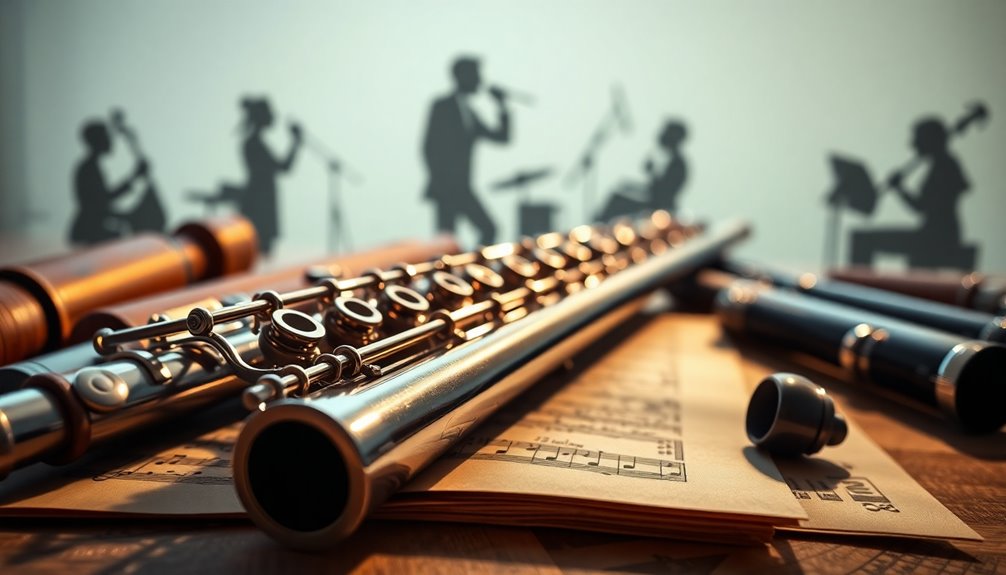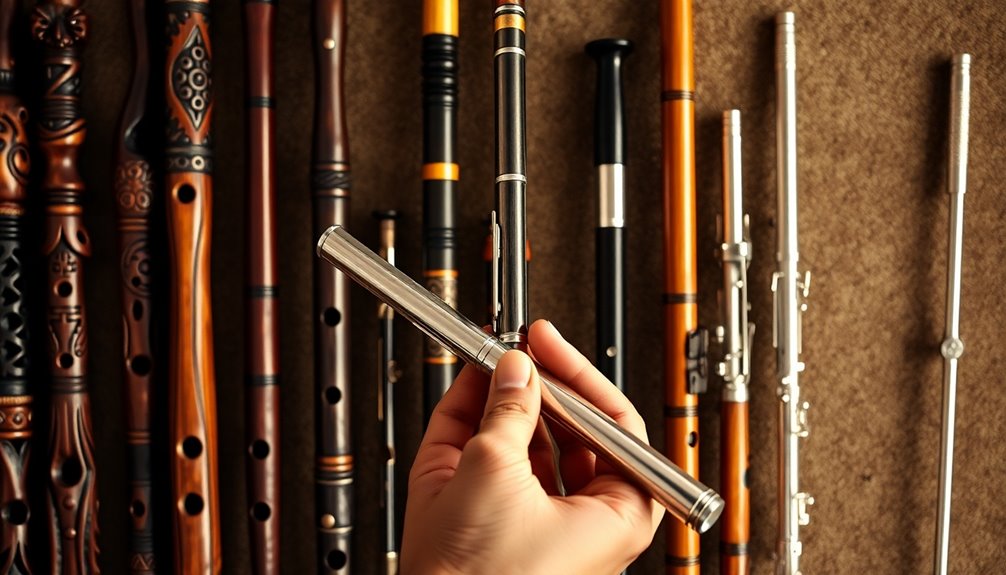Flute instruments have a remarkable journey through time, tracing back over 35,000 years to prehistoric origins. You'll find ancient flutes made from bird bones and ivory, reflecting cultural rituals and community ties. As you explore, notice how flutes evolved through the Renaissance and Baroque eras, becoming integral to orchestras and chamber music. Innovations like the Boehm system modernized design and accessibility, while 20th-century styles introduced jazz and unique techniques. Today, flutists fuse traditional and contemporary elements, shaping an evolving narrative in music. If you're intrigued, there's so much more to uncover about the evolution and significance of these enchanting instruments.
Key Takeaways
- Prehistoric flutes date back 35,000 years, showcasing early humans' creativity and social connections through music.
- The Renaissance and Baroque periods saw flutes evolve in design and musical complexity, enhancing their role in orchestras.
- The Classical Period highlighted the flute's emotional depth, with composers like Mozart integrating it into chamber music.
- Modern innovations, such as the Boehm system and materials like silver, improved the flute's sound quality and playability.
- Contemporary flutists explore diverse techniques and genres, blending acoustic and electronic elements while embracing multicultural influences.
Origins of the Flute

Have you ever wondered how the flute, one of the oldest musical instruments, came to be? The origins of the flute stretch back to prehistoric times, with archaeological findings revealing flutes made from bird bones and mammoth ivory, dating as far back as 35,000 years.
These prehistoric flutes not only demonstrate the ingenuity of early humans but also highlight the deep-rooted connection between music and culture.
You might be surprised to learn that these ancient instruments were crafted in various shapes and sizes, reflecting the available materials and the unique artistic expressions of their makers. Each flute served not only as a means of entertainment but also played a role in social and ritualistic practices.
Imagine gathering around a fire, where the haunting melodies of a flute weave stories and emotions, creating a sense of belonging within the community.
The cultural significance of the flute extends beyond mere sound; it embodies the essence of human experience. In many prehistoric societies, music was integral to ceremonies, celebrations, and even healing practices. The evolution of the flute from prehistoric flutes made from bone and wood to more advanced designs underscores its enduring presence in human culture.
The flute became a vessel through which individuals expressed their joys, sorrows, and spiritual beliefs, fostering a collective identity among those who played and listened.
Understanding these origins enriches your appreciation for the flute today. By recognizing its past, you reconnect with a timeless tradition that transcends generations, reminding you that music, in all its forms, can bring people together, creating bonds that last a lifetime.
Ancient Flutes Across Cultures

Exploring ancient flutes across various cultures reveals a fascinating tapestry of musical innovation and social significance. You'll find that these instruments, crafted from diverse flute materials like bone, wood, and reeds, served not merely as tools for entertainment but as essential components of communal identity and ritualistic practices.
In ancient cultures, the flute held profound meanings. For instance, in the Americas, Indigenous peoples created flutes from river reeds and clay, using them in ceremonies to connect with nature and ancestors. The haunting melodies were believed to summon spirits, fostering a sense of belonging within tribes.
Meanwhile, in ancient China, flutes called dizi were made from bamboo, symbolizing harmony and balance. Their use in rituals and celebrations not only showcased musical prowess but also reinforced social ties among communities. Each note played on these flutes echoed the collective identity of those who performed them.
In Europe, the earliest flutes, often fashioned from wood or ivory, appeared in medieval times. These instruments became a staple in courts, uniting people through music during festivities and gatherings. Flutes have evolved over centuries into various forms, including the Western Concert Flute, showcasing their adaptability and enduring appeal.
The choice of materials often reflected the status and cultural values of the time, as more intricate designs emerged to express sophistication and elegance.
The Renaissance and Baroque Era

The Renaissance and Baroque eras marked a pivotal evolution in flute design and musical expression, reflecting the period's broader cultural shifts. You'd find that during the Renaissance, the flute began to transform from a simple, wooden instrument to a more sophisticated design, allowing for greater tonal variety and technical capabilities. Musicians embraced these changes, diving into the richness of Renaissance music where the flute played a significant role in both ensemble and solo performances.
As the Baroque era emerged, composers began to write more intricate and expressive pieces, showcasing the flute's unique sound. This period highlighted the instrument's flexibility within various musical contexts, from orchestral settings to chamber music. You could feel the emotion and artistry that flourished during this time, as flutists explored new techniques and styles. This transformation also paved the way for engaging and enjoyable selections that would resonate with audiences for centuries to come.
To help you visualize this transformation, consider the following table:
| Era | Characteristics |
|---|---|
| Renaissance | Wooden, simple design; melodic focus in music |
| Baroque | Keyed flutes; complex compositions and ornamentation |
| Technique | Breath control and articulation improvements |
| Repertoire | Expanded to include virtuoso solo and ensemble pieces |
| Emotion | Expressive phrasing and dynamic contrasts |
This evolution in flute design and Baroque composition not only enhanced musical expression but also fostered a sense of community among musicians, creating spaces where you could truly belong and share your passion for this beautiful instrument.
The Classical Period

During the Classical Period, which spanned roughly from 1750 to 1820, the flute underwent significant advancements that further refined its design and expanded its role in orchestral music. This era saw the rise of notable flute composers like Wolfgang Amadeus Mozart and Joseph Haydn, who embraced classical techniques to showcase the instrument's capabilities. Their compositions not only highlighted the flute's lyrical qualities but also integrated it into the broader orchestral texture.
As you investigate the works of these composers, you'll notice how they utilized the flute to convey emotion, often employing intricate melodies and harmonies that resonated with the audience. The flute began to emerge not just as a solo instrument but as a crucial component of chamber ensembles and orchestras. This dual role allowed performers to explore a wider range of musical expression.
Moreover, the Classical Period emphasized clarity and balance in musical composition, aligning perfectly with the flute's agile sound. Composers crafted works that demonstrated the instrument's ability to execute rapid passages and graceful, flowing lines, which became hallmarks of the style. You might find it fascinating how the flute adapted to the evolving musical landscape, reflecting the tastes and sensibilities of the time. Additionally, the emotional depth of flute music during this era contributed to its role in cultural creativity as a means of artistic expression.
Ultimately, the Classical Period marked a pivotal moment for the flute, establishing a foundation that would influence future generations. As you explore this rich history, you'll appreciate how these advancements shaped the flute's identity within the classical canon, making it an enduring symbol of musical artistry.
Innovations in Flute Design

Innovations in flute design revolutionized the instrument, enhancing its playability and expanding its repertoire. You mightn't realize how much these advancements have shaped your experience as a flutist. The incorporation of modern materials like silver, gold, and even alloys has led to flutes that aren't only more durable but also capable of producing a richer, more vibrant sound.
These materials allow for precise craftsmanship and contribute to the overall tonal quality, giving you a wide range of expressive possibilities.
Ergonomic designs have also played a significant role in making the flute more accessible and comfortable for players of all skill levels. You'll find that the positioning of keys and the weight distribution of contemporary flutes cater to your natural hand movements, reducing fatigue during long practice sessions or performances.
This thoughtful consideration helps you focus on your musical expression rather than struggling with an unwieldy instrument.
Additionally, innovations like the offset G key and the addition of various key mechanisms have made it easier for you to execute intricate passages and extend your technical capabilities. These features not only enhance your performance but also invite you to explore new genres and styles, fostering a deeper connection with the music.
As you explore these innovations, you not only improve your skills but also become part of a broader community of musicians who appreciate the evolution of the flute. Embracing these advancements allows you to connect with the rich history of the instrument while carving out your unique musical journey. Moreover, the use of high-grade materials ensures that flutes are not only aesthetically pleasing but also robust and long-lasting.
The 20th Century Evolution

As advancements in flute design laid the groundwork for greater musical exploration, the 20th century emerged as a pivotal period for the instrument, characterized by significant stylistic and technical evolution. During this time, flutists began to embrace a wider range of genres, particularly jazz, which introduced unique demands and creative expressions. Jazz flutes, often crafted with specific tonal qualities and enhanced techniques, became essential for artists seeking to blend traditional classical elements with improvisational freedom.
You'd notice that the modern techniques developed in this era allowed for unprecedented flexibility in playing styles. Flutists explored extended techniques, incorporating multiphonics and flutter-tonguing, pushing the boundaries of what the flute could convey. This experimentation wasn't just about sound; it was about identity. Flutists began to carve out their own musical voices, reflecting personal experiences and cultural backgrounds through their performances.
Moreover, the introduction of the Boehm system revolutionized the instrument, making it more accessible for players of all levels. This system facilitated quicker fingerings and improved intonation, igniting a surge of interest in the flute across various music communities. As a result, many beginners gravitated toward reputable brands like Yamaha Flutes, which are designed to support new players in their musical journey.
As you engage with the 20th-century repertoire, you'll find that it mirrors the societal shifts of the time, offering a rich tapestry of emotional depth and technical prowess. The evolution of the flute during this century not only redefined its role within ensembles but also fostered a sense of belonging among diverse groups of musicians, uniting them through the universal language of music.
Contemporary Flute Practices

The vibrancy of contemporary flute practices reflects a dynamic fusion of tradition and innovation, where flutists navigate an expansive musical landscape. In today's world, you'll encounter modern techniques that push the boundaries of sound production, enabling you to explore extended techniques like multiphonics and circular breathing. These methods invite you to experiment, creating a unique voice that resonates with personal expression.
Digital integration has revolutionized how you approach performance and composition. With the aid of technology, you can blend live flute sounds with electronic elements, expanding your creative palette. This integration encourages you to collaborate with contemporary composers who often write for both acoustic and digital formats, further enriching your repertoire.
As you investigate improvisational styles, you'll find influences from diverse cultures, allowing you to draw on global traditions that enhance your playing. Multicultural influences not only broaden your musical perspective but also foster a sense of belonging in a community that values diversity.
Contemporary performance practices emphasize authenticity and connection with your audience. Whether you're performing in a formal concert hall or an intimate setting, your ability to convey emotion through the flute is crucial. Mastery of techniques such as breath control and circular breathing enhances your performance, allowing for seamless expression in extended passages.
The interplay of these elements creates a rich tapestry of contemporary flute practices, inviting you to be part of an ever-evolving narrative. Through this journey, you'll discover that your voice as a flutist isn't just a reflection of the past but a significant contributor to the future of music.
Frequently Asked Questions
What Materials Are Modern Flutes Commonly Made From?
Modern flutes are primarily crafted from metal or wood, each offering unique sound qualities.
Metal flutes, often made from silver or gold, provide a bright, clear tone that's popular among orchestral players.
On the other hand, wooden flutes, typically crafted from grenadilla or bamboo, deliver a warmer, richer sound, favored in folk and traditional music.
Understanding these materials can deepen your appreciation for the diverse range of flutes and the music they create together.
How Do I Choose the Right Flute for a Beginner?
Choosing the right flute for a beginner involves understanding the different flute types available.
Start with a student model, as these are designed for ease of play. Look for features like a closed hole design, which simplifies finger placement.
Consider the material; silver-plated flutes are popular for beginners. It's also helpful to ask for recommendations from teachers or experienced players.
What Are the Health Benefits of Playing the Flute?
Playing the flute is like releasing a bird from a cage, offering you stress relief and a sense of freedom.
As you master breath control, you not only enhance your musical skills but also improve your lung capacity and overall health.
The rhythmic flow of notes can calm your mind, fostering a sense of belonging within a community of musicians.
Each practice session becomes a step towards emotional well-being and self-expression.
Can You Play the Flute in Different Musical Genres?
Absolutely, you can play the flute in various musical genres, showcasing its versatility.
Whether you're diving into classical, jazz, folk, or pop, the flute adapts beautifully. Its unique timbre and expressive range allow for intricate melodies and soulful improvisations.
You'll find that experimenting with different styles not only enhances your skills but also deepens your connection to the music.
Embrace this genre adaptation, and you'll discover endless possibilities for your flute playing journey.
How Often Should a Flute Be Maintained or Serviced?
You should prioritize flute maintenance to guarantee peak performance.
Generally, it's best to have your flute serviced at least once a year, but if you play frequently or notice issues, consider more regular check-ups.
Routine maintenance includes cleaning, checking pads, and adjusting springs.
Conclusion
As you explore the flute's evolution, you can't help but marvel at its journey from primitive bone instruments to the sophisticated metal designs of today. Each era, with its unique influences and innovations, contrasts sharply with the last, yet they all harmonize to create the rich tapestry of flute music we cherish. Whether you're a budding musician or an avid listener, understanding this historical context deepens your appreciation for the melodies that have transcended time.






